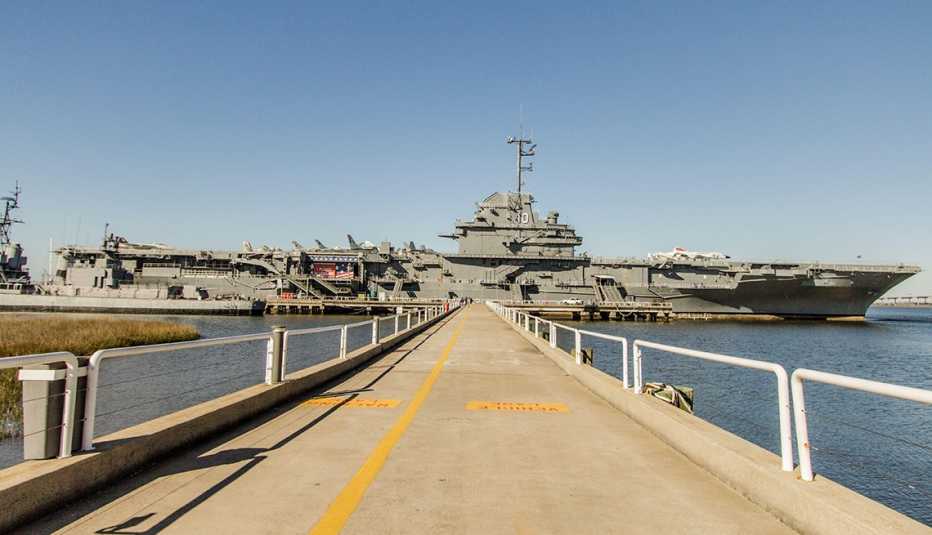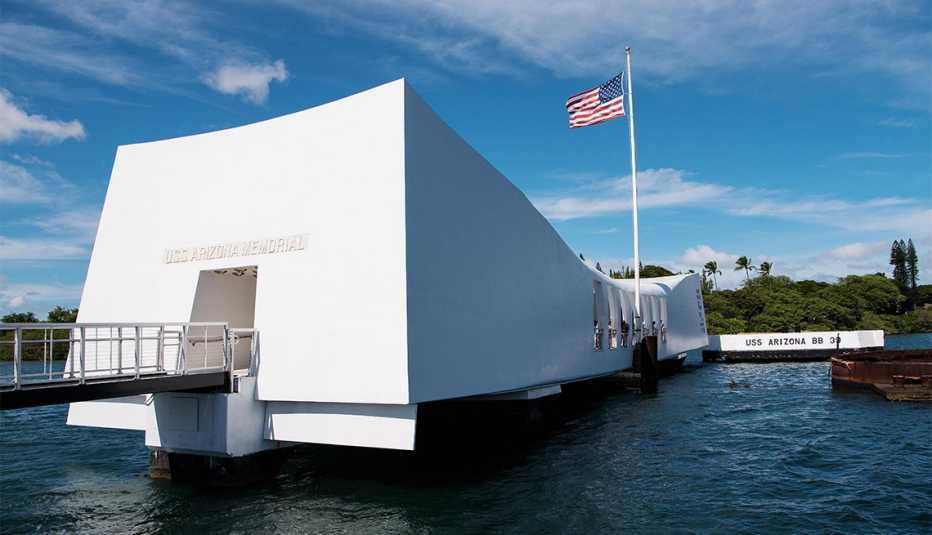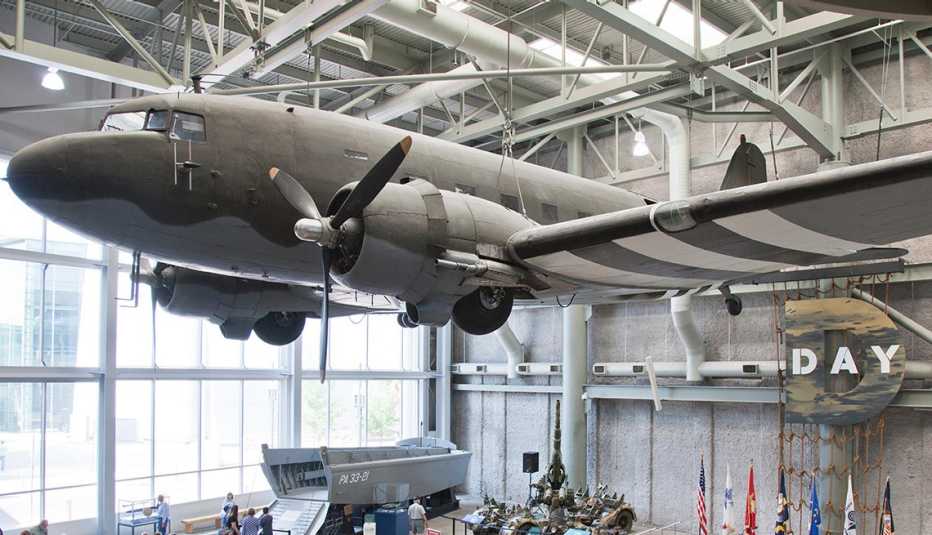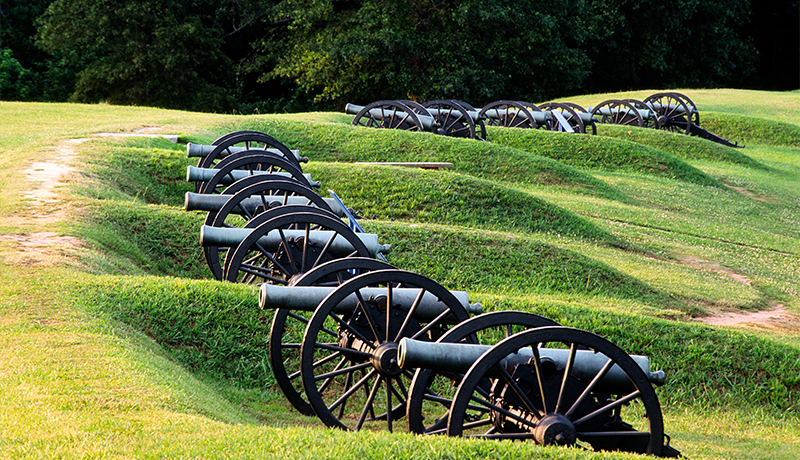AARP Hearing Center


COVID-19 update: The Patriots Point Naval & Maritime Museum encourages social distancing and face coverings (but doesn’t require them). To avoid a line, purchase tickets online ahead of your visit. Check the website for more updates.
Walking the 200-yard pier that leads to the Patriots Point Naval & Maritime Museum (PPNMM) gives you plenty of time to take in the USS Yorktown. As you approach the 880-foot-long, 27,000-ton aircraft carrier, it’s hard not to think of anything but the brave young sailors who fought for our freedom aboard this ship in so many conflicts, beginning with World War II. You’ll likely feel equal parts solemn and admirative, especially if any of your loved ones served in the Navy, as did my grandfather in World War II.
The PPNMM, which opened in January 1976, sits just across the harbor from Charleston in Mount Pleasant, South Carolina. Besides the Yorktown, it offers four other military components: the Medal of Honor Museum, the USS Laffey destroyer, the USS Clamagore submarine and the Vietnam Experience.
The Yorktown ranks as the museum’s biggest draw, and it's where you’ll want to dedicate most of your time. Construction on the massive ship began in Newport News, Virginia, in December 1941, shortly after the Japanese attacked Pearl Harbor. The Navy launched the newly built ship into the water in January 1943, commissioned it three months later, then immediately put it into service in World War II. The champagne bottle didn’t break when first lady Eleanor Roosevelt christened the carrier, which supposedly brings bad luck to a ship. But only 141 men perished on the Yorktown in its nearly three decades of service, including participation in 40 battles in World War II and the Korean and Vietnam wars. Nicknamed the “Fighting Lady,” it earned 11 battle stars for its service in World War II and five for its Vietnam duty. The Navy decommissioned it in 1970 and berthed it at Patriots Point in 1975.


Captain’s tour
With your PPNMM ticket, you can roam the Yorktown on your own, but given the ship’s many nooks and crannies, it’s best to take the 90-minute Captain’s Tour ($39, including admission). Not only do the volunteer guides make sure you see everything without getting turned around, they’re also mostly veterans who often share their own intriguing military stories. My group’s humble guide, Tom Simons, didn’t reveal it at the time, but I later discovered he was with the Blue Angels in the ’70s.
Be prepared to cover a lot of ground: The ship was a virtual city, with about 3,200 men aboard at any given time. “Everybody had everything they needed, and nothing that they didn’t,” Simons says. Translated: Streamlined living and working were happening here long before minimalism became a trend.
First tour stop: an exhibit on the Doolittle Raid — the surprise attack on April 18, 1942, that President Roosevelt ordered in response to Pearl Harbor — located on the Yorktown’s main (hangar) deck. You’ll immediately notice a restored B-25 Mitchell bomber, the type of aircraft fighter pilots used to take off from the USS Hornet (an aircraft carrier similar to the Yorktown) and successfully bomb their Japanese targets. All 16 of the planes used in the raid ran short on fuel by the end of the mission, with one pilot diverting his aircraft to Soviet Russia and the other 15 crash-landing or bailing out of their planes. Miraculously, 73 of the 80 involved in the dangerous mission survived.
Only those on the Captain’s Tour can climb up into the restored bomber, which I eagerly do. Looking around inside, I imagine what it must have been like to fly one of these planes for 10 hours during an attack — with no restroom on board, at that.
Moving on from the exhibit, you’ll start to explore the Yorktown’s seven decks open to tour. (Floors below the main deck are called “decks,” while those above it are “levels.”) A narrow staircase (navigating a naval ship isn’t a stroll in the park) leads down to Deck 2 and the chapel, with wooden pews, hymnals and framed photos of clergymen who had served on the ship, such as Father “Holy Joe” Moody. In March 1945, it fell on his shoulders to put five men injured in a bomb attack on the Yorktown at peace before they died.
Down a tight hallway with walls painted mint green, you’ll pass through a communal restroom, a workshop where sailors assembled torpedo bodies and a room with hanging cots that slept 36 men. Head down more stairs to Deck 3, where you’ll find a machine shop, a bomb elevator (which transported bombs assembled below deck to the flight deck to be loaded onto planes) and the scullery. A recipe affixed to the bakery room wall lists the ingredients for 10,000 cookies, including 500 eggs. Fresh-baked cookies was one way the Navy reminded sailors of home. Today the Yorktown smells like jet fuel rather than fresh-baked cookies. It's not overpowering, but the smell hits veterans hard on tours, Simons says, who has noticed more than one tear up after breathing it in, as it takes them back to their service days.
Warplanes and radar equipment
Exiting the fo’c’sle deck and ascending several levels of the ship through the crew’s berthing area, the tour takes you up to the flight deck and 10 of the most significant aircraft in U.S. carrier aviation history, including the AD-4N Skyraider, F4F Wildcat, F6F Hellcat and SBD Dauntless. Depending on how much of an aerophile you are, you can spend a few minutes or a couple hours wandering among them, and even climb inside the SH-3G Sea King, an anti-submarine helicopter.



































































